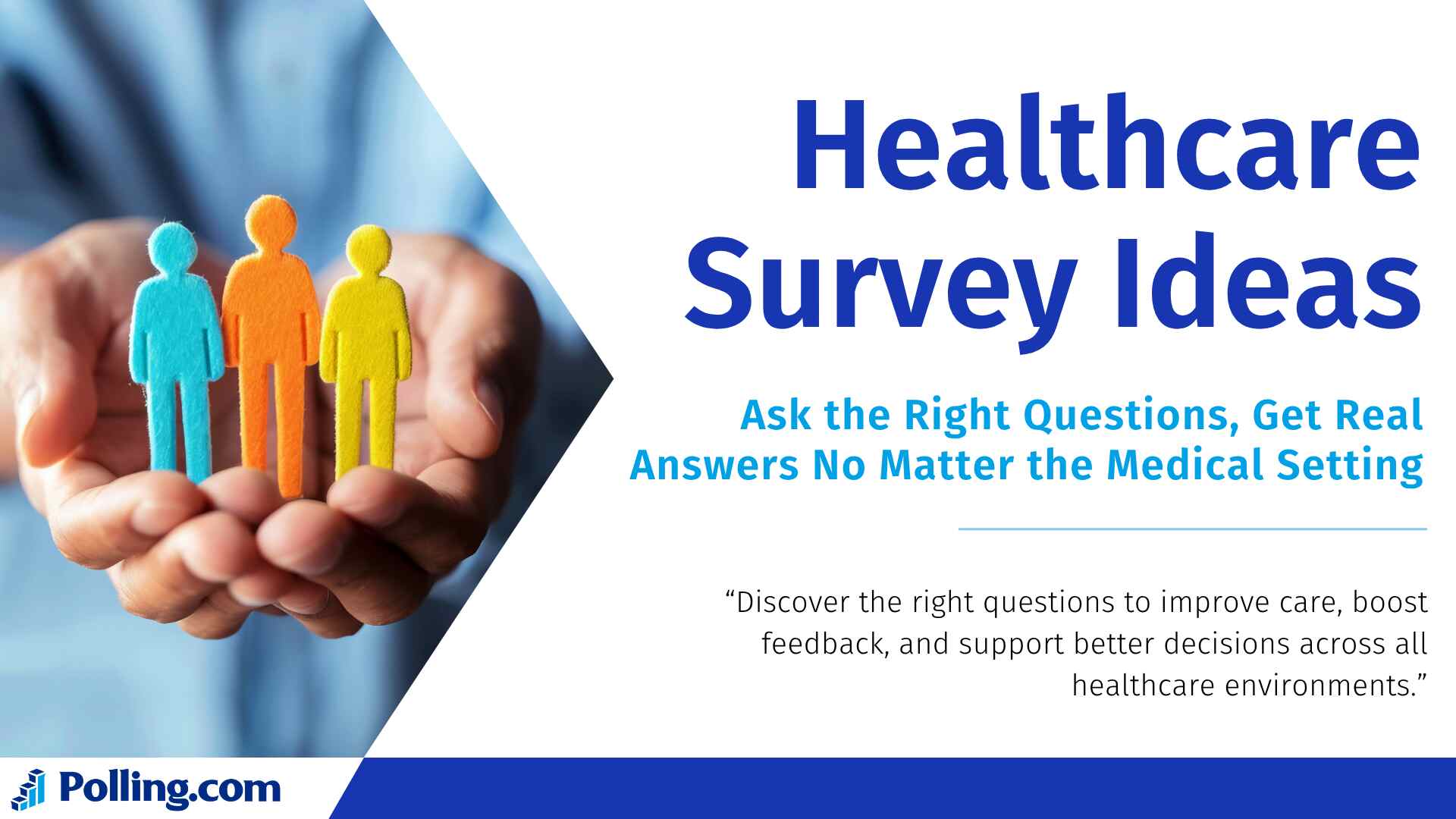
Healthcare Survey Ideas: Questions for Every Medical Setting
Healthcare survey tools are changing how hospitals, clinics, and practices gather feedback. These surveys don’t just collect opinions they improve services and create better patient experiences. But what do patients, staff, and insurance users truly need?
To answer that, you must ask the right questions.
Well-designed healthcare surveys can reveal issues such as long wait times, billing confusion, and staff burnout. In this article, you’ll discover why surveys are essential, best practices for building them, copyable questions for different healthcare settings, and how to use Polling.com a top survey platform to make the entire process seamless.
Let’s explore how to make your healthcare feedback strategy stronger.
Why Healthcare Surveys Matter
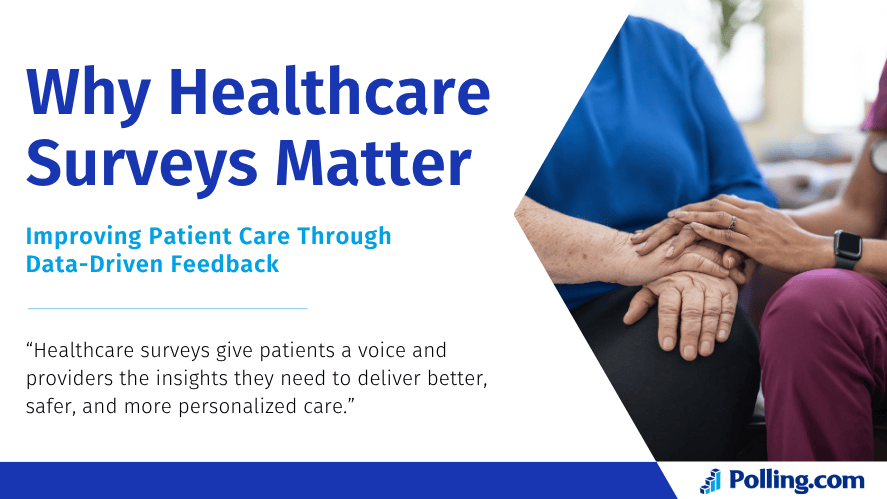
Surveys in healthcare do much more than collect opinions. They drive improvements, uncover gaps, and shape decisions that impact real outcomes. Here are four major reasons why healthcare providers use surveys.
1. Improve Patient Satisfaction and Retention
To begin with, patients care about more than medical results. They want respectful communication, short wait times, and a clean, welcoming environment. Therefore, a focused healthcare survey helps you understand their needs.
For example, if patients often mention poor communication, you can retrain staff. As a result, they’ll feel more understood and more likely to return or recommend your practice.
2. Comply With Health Standards and Regulations
In addition to care quality, privacy matters. When conducting a survey for healthcare, it’s vital to protect personal information and follow HIPAA regulations.
Because of this, using tools that offer HIPAA compliance like Polling.com ensures trust. Moreover, these surveys show that your facility values quality reviews and takes rules seriously.
3. Improve Efficiency With Staff Feedback
Meanwhile, your healthcare team is the heart of your operations. If they’re stressed or unsupported, it directly affects patient care. Fortunately, surveys give staff a chance to speak up.
By asking the right questions, you can uncover what’s working and what needs change. In turn, this improves morale and boosts patient satisfaction.
4. Spot Service Gaps With Market Research
In today’s competitive landscape, knowing what’s missing is just as important as knowing what works. A healthcare market research survey helps you stay ahead of patient needs and industry trends.
For instance, you may discover demand for telehealth or weekend hours. As a result, you can expand services, attract more patients, and improve outcomes.
Best Practices for Healthcare Surveys
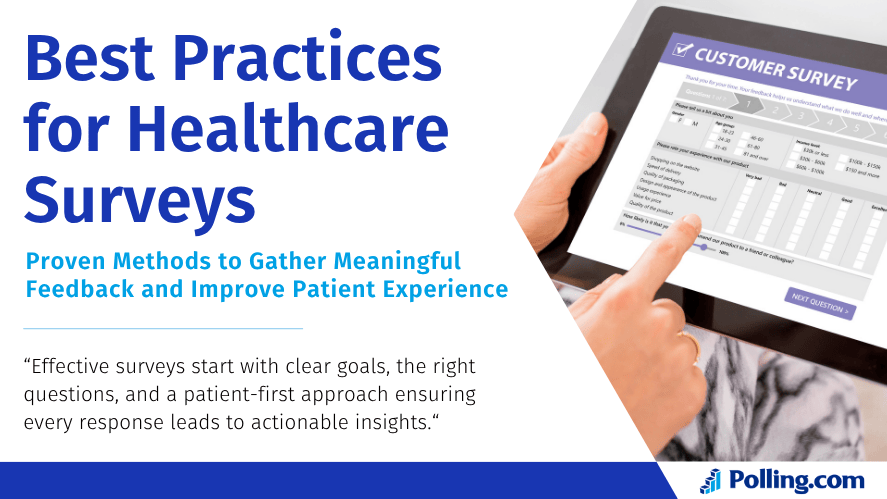
A successful healthcare survey doesn’t just ask questions it asks the right ones in the right way. Below are best practices that improve completion rates and data quality.
1. Keep It Short and Focused
To start, people are more likely to finish short surveys. Ideally, limit your survey to 5–10 minutes. Also, avoid medical jargon so your audience easily understands the questions.
For example:
- “How clean was the waiting area?”
- “Did your provider explain things clearly?”
Simple language increases clarity and response rates.
2. Maintain Privacy and HIPAA Compliance
Next, remember that trust is key. Explain how answers will be used, and reassure participants their data is protected.
Fortunately, using a secure survey platform like Polling.com makes this easy. In fact, they are fully HIPAA-compliant, making them perfect for any healthcare survey.
3. Choose the Best Delivery Method
In addition, how you deliver the survey matters. Depending on your patients or staff, different channels may be more effective.
You can use:
- Post-visit email
- Text message with a link
- Tablets or kiosks in the facility
- Printable QR codes
- Shareable Polling.com links
Because options vary, it’s smart to test a few and see what works best for your audience.
4. Use Polling.com for Easy Setup and Results
Creating a survey manually takes time. Thankfully, Polling.com simplifies every step. From prebuilt templates to live results dashboards, the platform supports every kind of healthcare survey.
Plus, it generates a medical information feedback diagram, so you can visualize what’s working and where to improve.
Healthcare Survey Ideas by Category
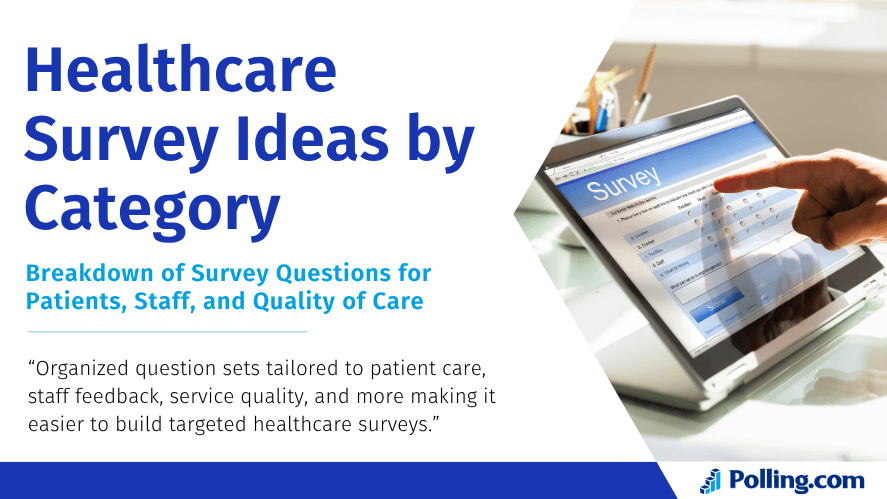
Now, let’s explore survey questions you can use right away. These are organized by setting, so you can easily choose the right ones for your clinic, hospital, or service type.
Patient Satisfaction Survey Questions
These questions focus on improving the patient experience. Use them in general practices, specialty clinics, or hospitals.
- “How clean and well-maintained did you find the facility during your visit?”
- “Did the provider explain your condition clearly?”
- “Were your concerns taken seriously?”
- “Was it easy to book your appointment?”
- “Would you recommend our facility to others?”
In summary, these help you enhance patient experience across every touchpoint.
Hospital Staff Feedback Survey Questions
Your staff is on the front line. Therefore, it’s important to know how they feel and what support they need.
- “Do you feel supported by management?”
- “Is your schedule manageable?”
- “Do you have access to the resources and equipment required to perform your duties effectively?”
- “Are internal communications effective?”
- “What changes would improve your workday?”
When used well, these questions lead to better retention and smoother workflows.
Mental Health Services Feedback Survey
Mental health care needs extra sensitivity. As such, these questions are designed to build trust and show respect.
- “Did you feel emotionally safe during your session?”
- “Were your concerns fully understood?”
- “Was privacy respected throughout your visit?”
- “Were treatment options clearly explained?”
- “Would you continue therapy here?”
Gathering this feedback strengthens patient trust and supports consistent care delivery.
Telehealth Experience Survey Questions
More people now rely on virtual visits. Therefore, it’s important to learn if those sessions meet their needs.
- “Was it easy to schedule your telehealth appointment?”
- “Did you experience technical issues?”
- “Was communication clear during the session?”
- “Did the virtual care meet your expectations?”
- “Would you use telehealth again?”
These questions guide improvements to your digital care strategy.
Cleanliness and Safety Survey Questions
Clean and safe environments build trust. Especially after COVID-19, these are top concerns.
- “Was hand sanitizer available?”
- “Did staff follow safety protocols?”
- “Did you feel safe during your visit?”
- “Were restrooms clean?”
- “How would you rate the overall safety of our facility?”
Such feedback helps maintain a safe, reassuring space for everyone.
Post-Discharge Patient Follow-Up Survey
What happens after care is just as important. Following up shows patients you care about recovery.
- “Were your post-discharge instructions clear?”
- “Did you face any problems at home?”
- “Did a staff member check in with you?”
- “Were you told how to take your medication?”
- “Do you feel ready for recovery?”
These answers help reduce readmissions and improve the patient journey.
Health Insurance and Billing Survey Questions
Billing confusion creates stress. Therefore, it’s important to ask about the financial experience.
- “Was the billing process explained clearly?”
- “Did you face any insurance claim issues?”
- “Were your out-of-pocket costs shared in advance?”
- “Was the billing team helpful and polite?”
- “How satisfied are you with our billing services?”
Fixing billing frustrations can significantly enhance patient experience.
How to Create a Healthcare Survey on Polling.com
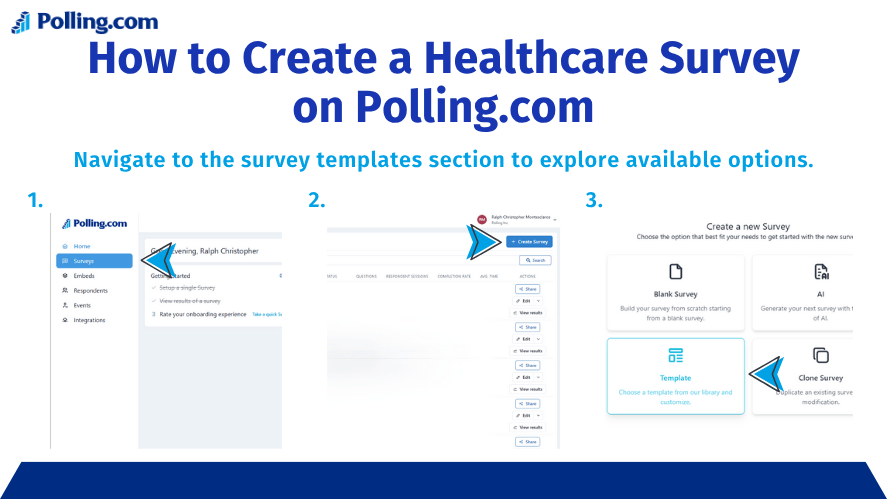
Creating effective surveys is simple even without technical experience. Polling.com makes the process easy and fast. Here’s how it works:
Step 1: Pick a Template
To begin, choose from ready-to-use templates for:
- Patient care
- Staff feedback
- Billing
- Cleanliness
- Telehealth
Step 2: Customize Your Questions
Next, add or remove questions. You can use the ones from this article or create your own survey question ideas.
Step 3: Send Your Survey
Then, share the survey using:
- SMS links
- Printed QR codes
- On-site tablets or kiosks
Step 4: Analyze the Results
Finally, view your data instantly with:
- Real-time dashboards
- Graphs and reports
- A custom medical information feedback diagram
- Export features for easy sharing
Because everything is centralized, decision-making becomes much easier.
Final Tips for Better Healthcare Surveying
Here are some closing tips to improve your results:
- Send surveys soon after care: This captures fresher feedback.
- Use both short and open-ended questions: This gives depth and metrics.
- Act on your results: Respond quickly to feedback to demonstrate that patient input drives real improvements.
- Review data regularly: Use it to adjust processes and train staff.
Also, don’t be afraid to try new survey ideas. Rotate in hot topic survey questions or test some fun survey ideas to keep things fresh.
Conclusion
To sum up, healthcare surveys are powerful tools for feedback, improvement, and growth. Whether you want better patient feedback, happier staff, or easier billing, surveys give you the answers you need.
With Polling.com, you can create, distribute, and analyze surveys easily all while staying HIPAA compliant.
👉 Start your healthcare survey for free with Polling.com and take your care experience to the next level.
